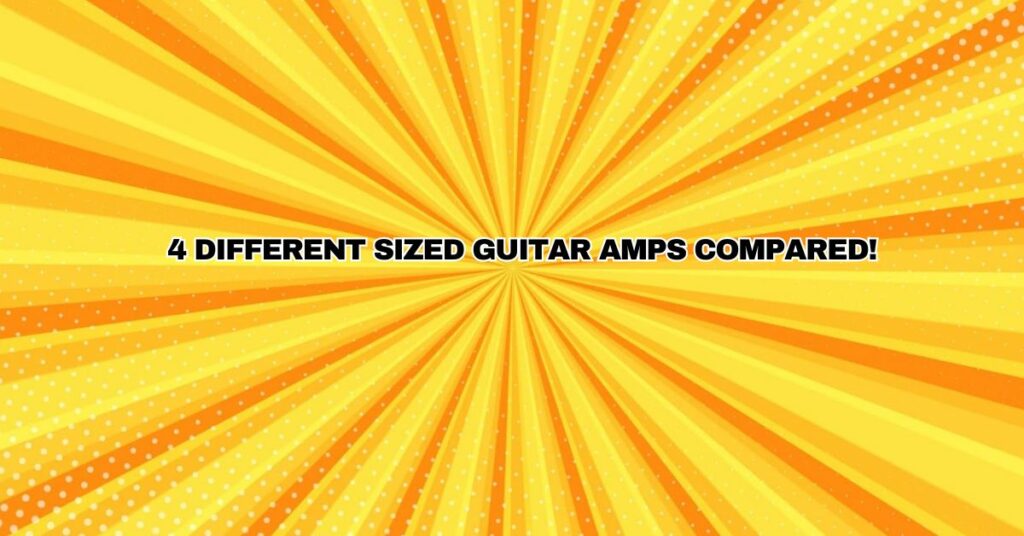The world of guitar amplifiers offers a wide array of options, not just in terms of brands and models but also in sizes. Amplifier size can significantly affect your sound, portability, and intended use. In this comprehensive article, we’ll explore and compare four different-sized guitar amplifiers, helping you understand the advantages and drawbacks of each size. Whether you’re a bedroom guitarist, a gigging musician, or a recording artist, finding the right-sized amplifier can make a world of difference in your musical journey.
1. Mini Amps (1-10 Watts)
Advantages:
- Portability: Mini amps are incredibly portable and lightweight. They are perfect for practicing on the go or taking to jam sessions.
- Low Volume: They provide the ability to practice quietly, making them ideal for late-night sessions or shared living spaces.
- Affordability: Mini amps are usually budget-friendly, making them a great choice for beginners.
- Variety: Despite their size, many mini amps now come with various features, including built-in effects and modeling options.
Drawbacks:
- Limited Power: Mini amps lack the wattage necessary for larger gigs or venues, so they are not suited for professional performances.
- Limited Tonal Range: Due to their size, mini amps may not deliver the full tonal spectrum that larger amps can offer.
- Volume Constraints: While they’re great for quiet practice, they may not be suitable for band rehearsals or performances with a live drummer.
2. Combo Amplifiers (10-50 Watts)
Advantages:
- Versatility: Combo amps are versatile and can cover a wide range of musical styles and venues, from small clubs to larger stages.
- Built-In Speaker: Combos come with built-in speakers, providing an all-in-one solution for amplification.
- Portability: While not as compact as mini amps, combos are still relatively portable and easier to transport compared to head and cabinet setups.
- Value for Money: Many combo amps offer a balance between affordability and quality, making them a popular choice for musicians at various levels.
Drawbacks:
- Weight: Some combo amps can be heavy and challenging to carry for extended periods.
- Limited Customization: Combos may have limited options for changing speakers or using multiple cabinets.
- Volume Constraints: While they can handle smaller gigs, they may struggle to project over loud drummers in larger venues.
3. Head and Cabinet (20-200 Watts)
Advantages:
- Power and Headroom: Head and cabinet setups provide ample wattage and headroom, making them suitable for professional gigs and large venues.
- Customization: They allow you to choose different speaker cabinets, providing a highly customizable setup.
- Tonal Versatility: The head and cabinet combination offers a wide tonal spectrum and greater sound control.
- Scalability: You can add extra cabinets for even more volume and presence.
Drawbacks:
- Size and Weight: Head and cabinet setups can be large and heavy, making them less portable.
- Cost: They tend to be more expensive compared to combos and mini amps.
- Complexity: Setting up and configuring a head and cabinet can be more involved, requiring a good understanding of signal chains.
4. Modeling Amplifiers
Advantages:
- Versatility: Modeling amplifiers can mimic the sounds of various amp models, making them incredibly versatile.
- Built-In Effects: Many modeling amps come with a range of built-in effects, reducing the need for external pedals.
- Portability: They are often more compact and lightweight than traditional amps with similar capabilities.
- Tonal Precision: You can fine-tune your sound by adjusting parameters and presets.
Drawbacks:
- Learning Curve: Modeling amps can be complex, requiring time to understand and optimize their features fully.
- Digital Sound: Some purists may argue that modeling amps lack the warmth and authenticity of traditional tube amplifiers.
- Upfront Cost: High-quality modeling amps can be pricey, though they may save money on effects pedals.
Conclusion
Selecting the right-sized guitar amplifier is a crucial decision that hinges on your playing style, performance requirements, and portability preferences. Mini amps are perfect for quiet practice and beginners, while combo amps offer versatility and portability for various settings. Head and cabinet setups provide power and customization for professionals, and modeling amplifiers deliver versatility and convenience with a digital touch.
Ultimately, the best-sized amplifier for you depends on your specific needs and musical goals. Consider your playing style, venue sizes, and budget to make an informed decision. Whether you’re a bedroom guitarist, a touring musician, or a recording artist, there’s an amplifier size that perfectly matches your aspirations and helps you achieve the sound you desire.


